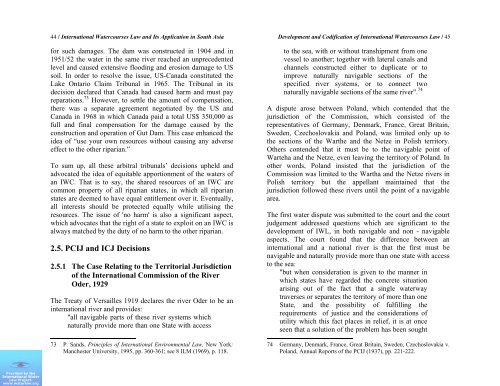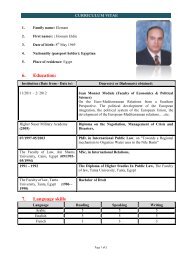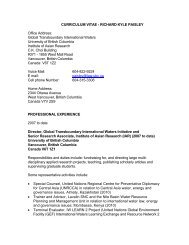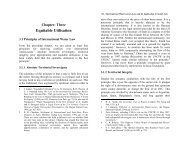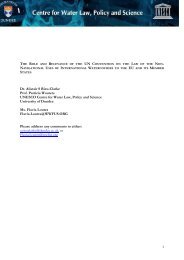Upreti, Trilochan, International Watercourses Law and Its Application ...
Upreti, Trilochan, International Watercourses Law and Its Application ...
Upreti, Trilochan, International Watercourses Law and Its Application ...
You also want an ePaper? Increase the reach of your titles
YUMPU automatically turns print PDFs into web optimized ePapers that Google loves.
44 / <strong>International</strong> <strong>Watercourses</strong> <strong>Law</strong> <strong>and</strong> <strong>Its</strong> <strong>Application</strong> in South Asia Development <strong>and</strong> Codification of <strong>International</strong> <strong>Watercourses</strong> <strong>Law</strong> / 45for such damages. The dam was constructed in 1904 <strong>and</strong> in1951/52 the water in the same river reached an unprecedentedlevel <strong>and</strong> caused extensive flooding <strong>and</strong> erosion damage to USsoil. In order to resolve the issue, US-Canada constituted theLake Ontario Claim Tribunal in 1965. The Tribunal in itsdecision declared that Canada had caused harm <strong>and</strong> must payreparations. 73 However, to settle the amount of compensation,there was a separate agreement negotiated by the US <strong>and</strong>Canada in 1968 in which Canada paid a total US$ 350,000 asfull <strong>and</strong> final compensation for the damage caused by theconstruction <strong>and</strong> operation of Gut Dam. This case enhanced theidea of “use your own resources without causing any adverseeffect to the other riparian.”To sum up, all these arbitral tribunals’ decisions upheld <strong>and</strong>advocated the idea of equitable apportionment of the waters ofan IWC. That is to say, the shared resources of an IWC arecommon property of all riparian states, in which all riparianstates are deemed to have equal entitlement over it. Eventually,all interests should be protected equally while utilising theresources. The issue of 'no harm' is also a significant aspect,which advocates that the right of a state to exploit on an IWC isalways matched by the duty of no harm to the other riparian.2.5. PCIJ <strong>and</strong> ICJ Decisions2.5.1 The Case Relating to the Territorial Jurisdictionof the <strong>International</strong> Commission of the RiverOder, 1929The Treaty of Versailles 1919 declares the river Oder to be aninternational river <strong>and</strong> provides:"all navigable parts of these river systems whichnaturally provide more than one State with access73 P. S<strong>and</strong>s, Principles of <strong>International</strong> Environmental <strong>Law</strong>, New York:Manchester University, 1995, pp. 360-361; see 8 ILM (1969), p. 118.to the sea, with or without transhipment from onevessel to another; together with lateral canals <strong>and</strong>channels constructed either to duplicate or toimprove naturally navigable sections of thespecified river systems, or to connect twonaturally navigable sections of the same river". 74A dispute arose between Pol<strong>and</strong>, which contended that thejurisdiction of the Commission, which consisted of therepresentatives of Germany, Denmark, France, Great Britain,Sweden, Czechoslovakia <strong>and</strong> Pol<strong>and</strong>, was limited only up tothe sections of the Warthe <strong>and</strong> the Netze in Polish territory.Others contended that it must be to the navigable point ofWarteha <strong>and</strong> the Netze, even leaving the territory of Pol<strong>and</strong>. Inother words, Pol<strong>and</strong> insisted that the jurisdiction of theCommission was limited to the Wartha <strong>and</strong> the Netze rivers inPolish territory but the appellant maintained that thejurisdiction followed these rivers until the point of a navigablearea.The first water dispute was submitted to the court <strong>and</strong> the courtjudgement addressed questions which are significant to thedevelopment of IWL, in both navigable <strong>and</strong> non - navigableaspects. The court found that the difference between aninternational <strong>and</strong> a national river is that the first must benavigable <strong>and</strong> naturally provide more than one state with accessto the sea:"but when consideration is given to the manner inwhich states have regarded the concrete situationarising out of the fact that a single waterwaytraverses or separates the territory of more than oneState, <strong>and</strong> the possibility of fulfilling therequirements of justice <strong>and</strong> the considerations ofutility which this fact places in relief, it is at onceseen that a solution of the problem has been sought74 Germany, Denmark, France, Great Britain, Sweden, Czechoslovakia v.Pol<strong>and</strong>, Annual Reports of the PCIJ (1937), pp. 221-222.


